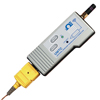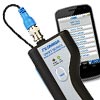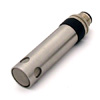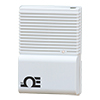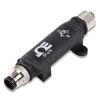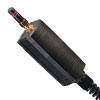"Precise temperature data leads to energy and time savings for leading roto-molding machine manufacturer."
Challenge
No Temperature Monitoring Mechanism Limits Precision
Roto-molding is a process used to mold thermoplastic material into various durable forms—anything from plastic toys to large objects such as water tanks. Roto-molding is not only one of the most economical and environmentally-friendly methods of molding plastic, it is also easier than any other method to manufacture large hollow parts, such as storage tanks.
However, precision is critical to the roto-molding process, which uses a roto-molding machine to slowly biaxially rotate a mold filled with polymer powder in a high-temperature environment. If the mold is removed too soon, the polymer grains may not have fully melted, leading to large bubbles in the polymer that can impact the look and performance of the finished product. If the mold is removed too late, the high-temperature environment will degrade the polymer, weakening the strength of the plastic.
Despite the need for precision, the roto-molding process has historically depended upon trial and error to determine the correct processing time. However, advances in technology have allowed for real-time process controls based on the temperature of the air inside the mold.
To achieve this improved process control, one leading roto machine manufacturer developed a separate chamber where a temperature sensor could measure a sample of the material exposed to the same temperatures as the product being molded. However, the manufacturer was still struggling with how to connect the sensors so that the temperature data could be transmitted and received in real-time. The most common way to do this would be with wires, but because of the rotational environment, any wires would get twisted and damaged during the molding process.
Solution
Serendipity Leads to the Perfect Solution
Coming across Omega’s products at a tradeshow, the roto-manufacturing company realized that Omega’s wireless temperature monitoring system might be the answer they’d been looking for to get real-time temperature data throughout the molding process.
The manufacturer worked with Omega’s Brazil office to configure two test systems, which used a wireless thermocouple connector to connect to temperature sensors inside the sample chamber and a wireless receiver with analog outputs to transmit the data. With the test systems up and running, the manufacturer was able to successfully use the system with its temperature sensors in its sample chamber to get accurate, real-time temperature readings.
Omega then worked with the manufacturer to ensure long-term success by offering warranty support and off-the-shelf stocking of the wireless solution. Since the manufacturer would be selling the wireless monitoring solution to their current and new customers as an add-on solution, having off-the-shelf access to the wireless monitoring system was important—allowing them to order the product on-demand without worrying about extended shipping delays.
Result
More Precision, Better Products
Driven to produce high-quality machines through applying cutting-edge innovation, the roto manufacturer tests its machines on-site at the factory. Through these tests, the manufacturer saw an improvement in the quality of parts their machines can produce with precise real-time temperature monitoring. The manufacturer has also realized energy and time savings due to more precise knowledge about when the molding process is complete.
With over 300 roto-molding machines worldwide on five different continents, the manufacturer is now able to offer its current and new customers the ability to install the wireless temperature monitoring solution in their machines to improve the molding process and achieve even more economical and environmental benefits from the roto-molding process.




